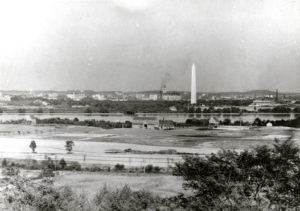
In 1900, Congress transferred 400 acres of land along the Potomac near Ft. Myer to the Department of Agriculture in order to create an experimental farm for plant testing and the improvement of plants and methods of cultivation.
The area had been neglected for many years and even the top soil had been taken for the National Cemetery. Over the years a number of interesting activities and experiments took place at the farm:
- Americans on governmental or private missions abroad were encouraged to send foreign plants home to see if they would help improve domestic plants. The farm naturalized over 100,000 types of foreign plants for domestic use; soybeans are one of the best known crops to be introduced this way.
- When a plant disease threatened to wipe out the domestic sugarcane industry in the 1920s, the Farm led the way in developing immunity to this blight which ultimately resulted in the rebuilding of the sugarcane industry.
- One of the more unusual examples of the Farm’s experiments involved grasses for golf greens. Before WWI the country’s golf courses were almost entirely dependent on German grown seed for their grasses. When the supply was cut off by the war, golf courses throughout the country contributed funds for experiments at Arlington to develop new domestic varieties.
With the development of Arlington National Cemetery and the construction of Memorial Bridge there was pressure to relocate the farm.
In 1932 much of the farm’s work was shifted to Beltsville, MD, and by 1941 the remainder of the property had been transferred to the War Department for use in the National Defense Program.
What About You?
Do you recall the Arlington experimental farm? Let us know what you remember!